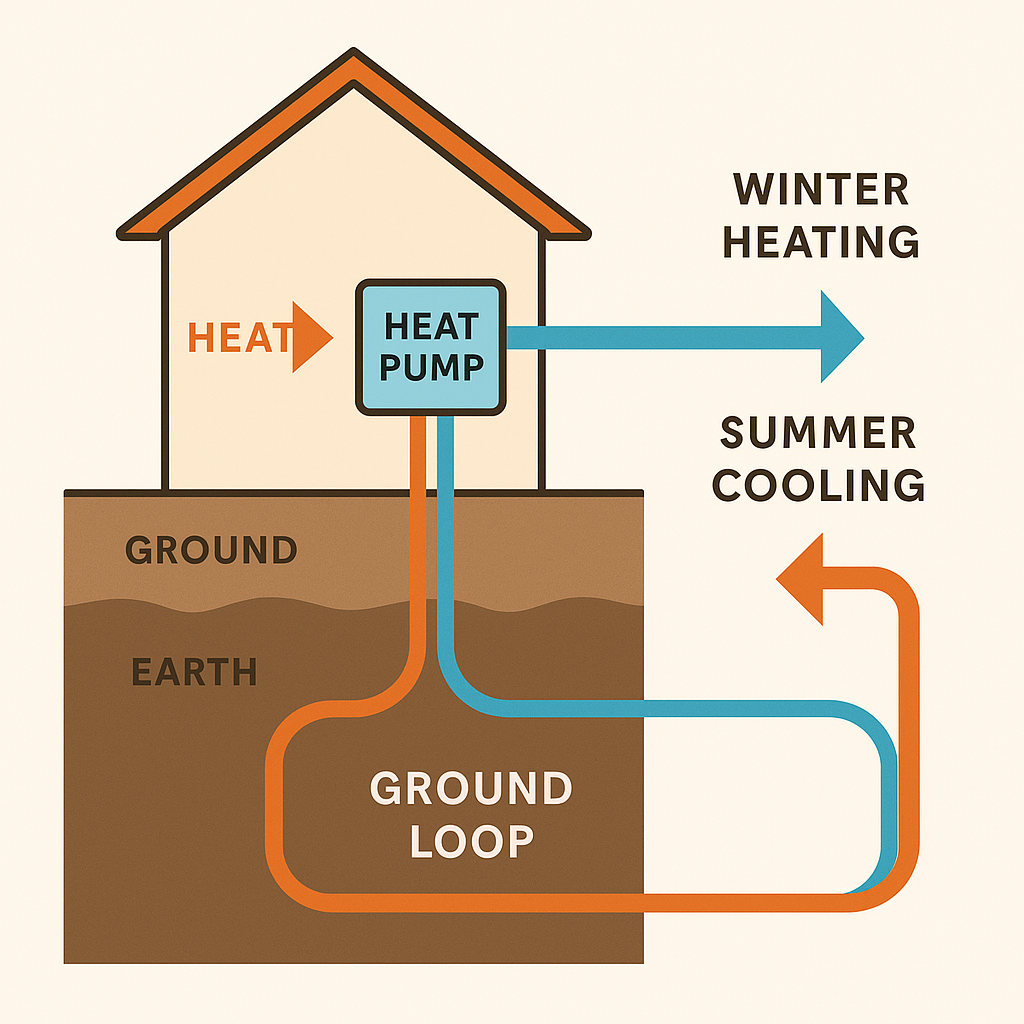As Utah residents search for more energy-efficient and sustainable ways to heat and cool their homes, geothermal heating and cooling is emerging as a top choice. Though the technology has been around for decades, recent advancements, increased incentive programs, and rising energy costs have made it more attractive than ever.
This blog covers everything you need to know about geothermal heating and cooling in Utah, including how it works, what it costs, the permit process, pros and cons, maintenance requirements, and why it’s becoming a smart investment for homeowners across the state.
What Is Geothermal Heating and Cooling?

Geothermal heating and cooling uses the stable temperature of the earth, typically around 50–60°F in Utah, to regulate your home’s climate. By installing a geothermal heat pump system, homeowners can harness underground thermal energy to heat their home in the winter and cool it in the summer.
Instead of burning fossil fuels or relying entirely on electricity to generate heat or cooling, a geothermal system moves heat to or from the ground using a loop system and a heat pump. This makes it incredibly efficient year-round, regardless of the outside temperature.
Why It’s Gaining Popularity in Utah
There are several reasons geothermal heating and cooling is trending in Utah right now:
- Rising Utility Costs: Traditional heating and cooling systems can be costly to operate, especially with Utah’s cold winters and hot summers. Geothermal systems reduce energy usage by 40–70%.
- Sustainability: As more homeowners seek eco-conscious solutions, geothermal offers a renewable and non-polluting alternative.
- Incentives: Utah homeowners now benefit from rebates like the Rocky Mountain Power Wattsmart program and federal tax credits covering up to 30% of installation costs.
- Long-Term Savings: Though the upfront costs are high, the long-term energy savings make geothermal systems a cost-effective investment over time.
What It Takes to Install a Geothermal System
Installing a geothermal system is a highly specialized process that involves both indoor and outdoor components. Here’s what it typically includes:
- Site Evaluation: A certified technician will assess your land and soil conditions to determine the best loop configuration,either vertical, horizontal, or pond/lake-based.
- Drilling or Excavation: Vertical loop systems require drilling 100–400 feet into the ground, while horizontal systems use trenches several feet deep.
- Heat Pump Installation: Inside your home, a heat pump unit is installed, typically in place of a traditional furnace.
- Loop Connection: The closed or open-loop piping system is connected to the heat pump, allowing heat transfer between your home and the earth.
Installation typically takes 2–3 weeks, depending on the site and complexity.
Permit Requirements in Utah
Utah’s Division of Water Rights regulates geothermal systems, especially open-loop types. The key requirements are:
- Closed-loop systems: Require a well permit, even though they do not extract water.
- Open-loop systems: Require a water right because they involve groundwater extraction and reinjection.
- Environmental Compliance: All installations must adhere to state environmental standards to protect groundwater quality.
Salt Lake, Utah, Davis, and Weber counties also have specific local regulations that may require building permits or inspections.
Costs to Consider
Installing geothermal heating and cooling in Utah typically costs between $20,000 and $30,000, depending on your home’s size, system type, and ground conditions. This cost includes the heat pump unit, loop installation, excavation, and labor.
While that may sound steep, consider these long-term financial benefits:
- Federal tax credits: Up to 30% of the installation cost.
- Wattsmart rebates: Additional savings depending on your utility provider.
- Energy savings: Homeowners often save 40–70% on heating and cooling bills, resulting in a payback period of 5–10 years.
Pros and Cons of Geothermal Systems
Pros
- High Efficiency: 300–600% efficiency compared to 90–98% for top-rated gas furnaces.
- Quiet Operation: No noisy outdoor compressors.
- Longevity: Ground loops last 50+ years; heat pumps last 20–25 years.
- Eco-Friendly: No on-site emissions and reduced carbon footprint.
Cons
- Upfront Cost: Significantly higher than conventional HVAC systems.
- Installation Disruption: Excavation or drilling can disturb landscaping.
- Permit Complexity: Water rights and well permitting can delay installation if not well managed.
Despite the challenges, the benefits are long-term and substantial, especially for homeowners looking to stay in their homes for decades.
Maintenance and Lifespan
One of the underrated benefits of geothermal heating and cooling is low maintenance:
- Heat Pump: Requires regular air filter changes and an annual system check.
- Ground Loops: Virtually maintenance-free and built to last over half a century.
- Antifreeze Monitoring: Closed-loop systems use antifreeze that may require periodic testing and top-off every 5–10 years.
Routine service ensures the system continues operating at peak efficiency with minimal breakdowns.
Is Geothermal Right for You?
Geothermal heating and cooling is one of the most efficient, sustainable, and future-forward HVAC solutions available in Utah. While the initial investment can be intimidating, the long-term savings, combined with environmental benefits and increasing incentive programs, make it a worthwhile consideration for many homeowners.
If you’re ready to explore geothermal as a real option, Authority Heating & Cooling is here to help. We’re proud to announce our new Geothermal Program, designed specifically for Utah homes. With tailored installation plans, expert permitting assistance, and access to rebates, we’ll walk you through every step of the process,from assessment to activation.
Interested in learning more? Contact Authority Heating & Cooling today and find out if geothermal is right for your home and your future.





